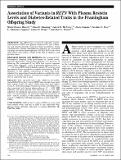| dc.contributor.author | Hivert, Marie-France | |
| dc.contributor.author | Manning, Alisa K. | |
| dc.contributor.author | McAteer, Jarred B. | |
| dc.contributor.author | Dupuis, Josée | |
| dc.contributor.author | Fox, Caroline | |
| dc.contributor.author | Cupples, L. Adrienne | |
| dc.contributor.author | Meigs, James Benjamin | |
| dc.contributor.author | Florez, Jose Carlos | |
| dc.date.accessioned | 2011-02-18T16:15:12Z | |
| dc.date.issued | 2009 | |
| dc.identifier.citation | Hivert, Marie-France, Alisa K. Manning, Jarred B. McAteer, Josée Dupuis, Caroline S. Fox, L. Adrienne Cupples, James B. Meigs, and Jose C. Florez. 2009. Association of variants in RETN with plasma resistin levels and diabetes-related traits in the Framingham offspring study. Diabetes 58, no. 3: 750-756. | en_US |
| dc.identifier.issn | 0012-1797 | en_US |
| dc.identifier.uri | http://nrs.harvard.edu/urn-3:HUL.InstRepos:4727657 | |
| dc.description.abstract | OBJECTIVE— The RETN gene encodes the adipokine resistin. Associations of RETN with plasma resistin levels, type 2 diabetes, and related metabolic traits have been inconsistent. Using comprehensive linkage disequilibrium mapping, we genotyped tag single nucleotide polymorphisms (SNPs) in RETN and tested associations with plasma resistin levels, risk of diabetes, and glycemic traits. RESEARCH DESIGN AND METHODS— We examined 2,531 Framingham Offspring Study participants for resistin levels, glycemic phenotypes, and incident diabetes over 28 years of follow-up. We genotyped 21 tag SNPs that capture common (minor allele frequency >0.05) or previously reported SNPs at r2 > 0.8 across RETN and its flanking regions. We used sex- and age-adjusted linear mixed-effects models (with/without BMI adjustment) to test additive associations of SNPs with traits, adjusted Cox proportional hazards models accounting for relatedness for incident diabetes, and generated empirical P values (Pe) to control for type 1 error. RESULTS— Four tag SNPs (rs1477341, rs4804765, rs1423096, and rs10401670) on the 3′ side of RETN were strongly associated with resistin levels (all minor alleles associated with higher levels, Pe<0.05 after multiple testing correction). rs10401670 was also associated with fasting plasma glucose (Pe = 0.02, BMI adjusted) and mean glucose over follow-up (Pe = 0.01; BMI adjusted). No significant association was observed for adiposity traits. On meta-analysis, the previously reported association of SNP −420C/G (rs1862513) with resistin levels remained significant (P = 0.0009) but with high heterogeneity across studies (P < 0.0001). CONCLUSIONS— SNPs in the 3′ region of RETN are associated with resistin levels, and one of them is also associated with glucose levels, although replication is needed. | en_US |
| dc.language.iso | en_US | en_US |
| dc.publisher | American Diabetes Association | en_US |
| dc.relation.isversionof | doi://10.2337/db08-1339 | en_US |
| dc.relation.hasversion | http://www.ncbi.nlm.nih.gov/pmc/articles/PMC2646076/pdf/ | en_US |
| dash.license | LAA | |
| dc.title | Association of Variants in RETN with Plasma Resistin Levels and Diabetes-Related Traits in the Framingham Offspring Study | en_US |
| dc.type | Journal Article | en_US |
| dc.description.version | Version of Record | en_US |
| dc.relation.journal | Diabetes | en_US |
| dash.depositing.author | Fox, Caroline | |
| dc.date.available | 2011-02-18T16:15:12Z | |
| dash.affiliation.other | HMS^Medicine-Brigham and Women's Hospital | en_US |
| dash.affiliation.other | HMS^Medicine-Massachusetts General Hospital | en_US |
| dash.affiliation.other | HMS^Medicine-Massachusetts General Hospital | en_US |
| dc.identifier.doi | 10.2337/db08-1339 | * |
| dash.contributor.affiliated | Florez, Jose | |
| dash.contributor.affiliated | Meigs, James | |
| dash.contributor.affiliated | Fox, Caroline | |


